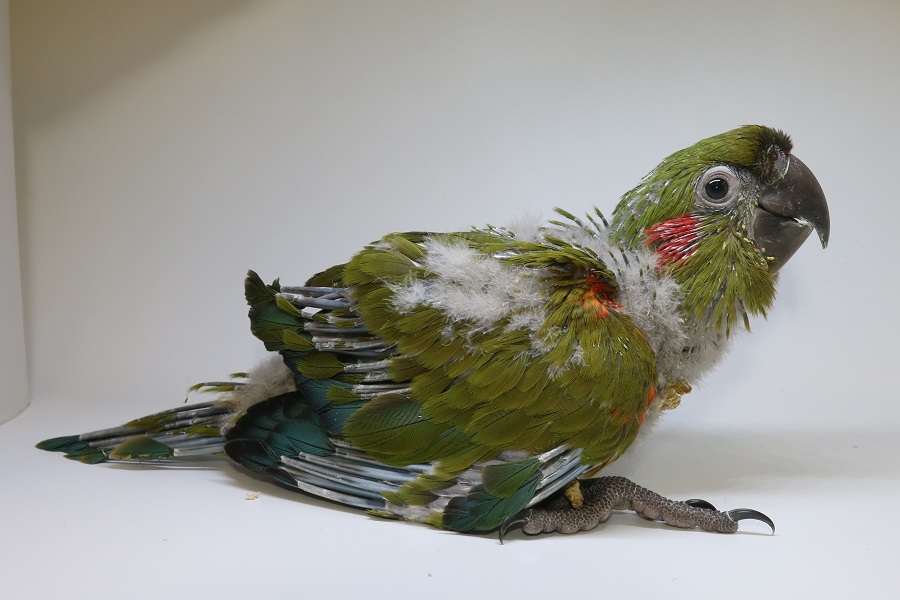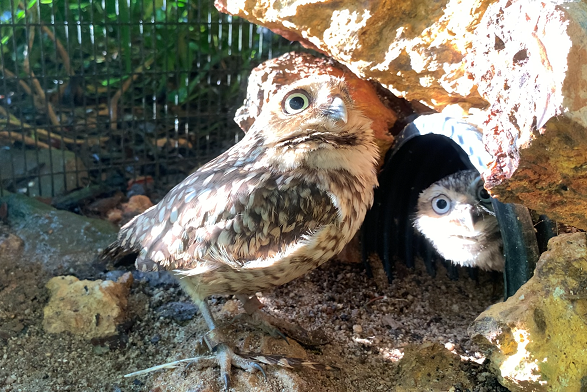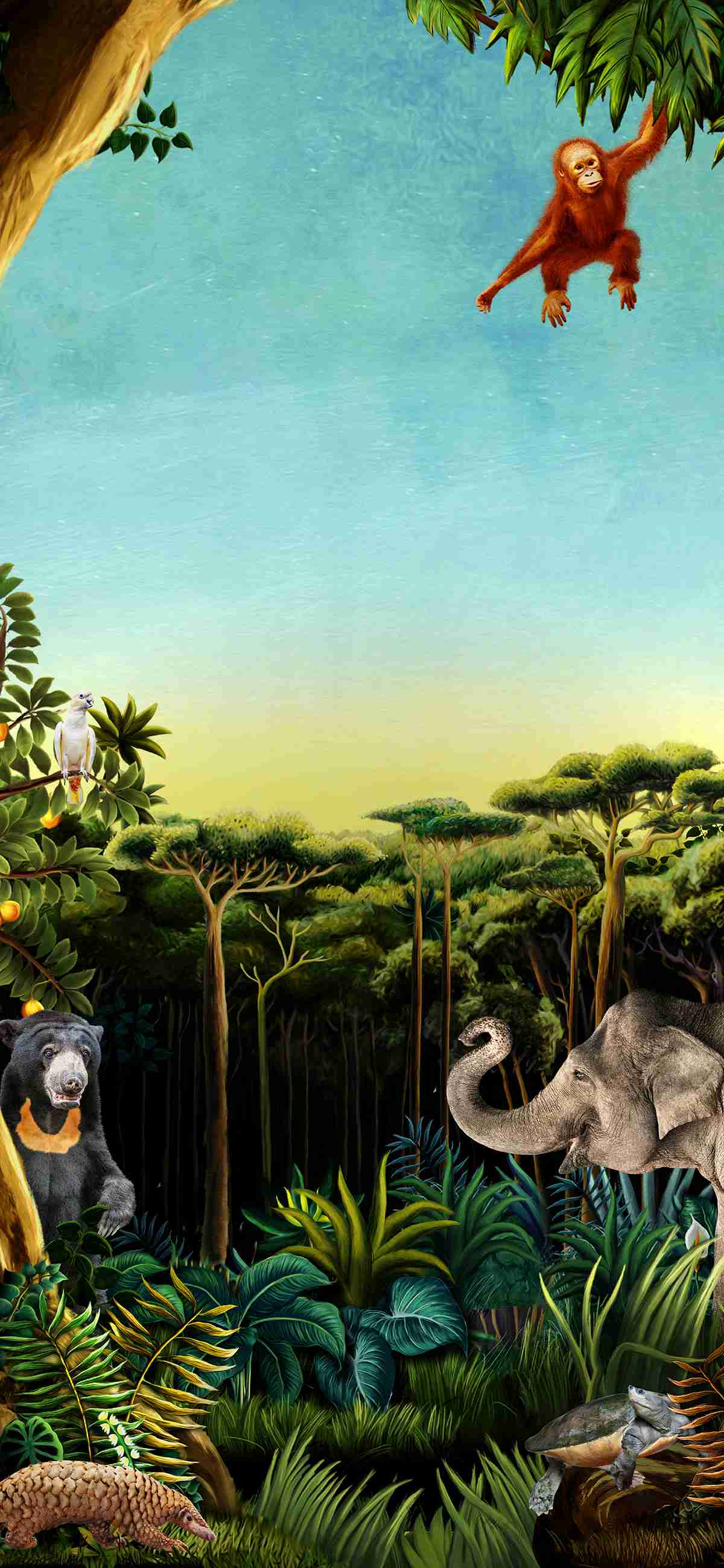Conservation in Jurong Bird Park gets a boost with over 100 hatchlings
24 JUL 2020 A red-fronted macaw at 46 days old (left) hatched in Jurong Bird Park’s Breeding & Research Centre and. Threatened by habitat loss and poaching, breeding the critically endangered species under human care is crucial for their continued survival.
A red-fronted macaw at 46 days old (left) hatched in Jurong Bird Park’s Breeding & Research Centre and. Threatened by habitat loss and poaching, breeding the critically endangered species under human care is crucial for their continued survival. An adult red-fronted macaw at Jurong Bird Park
An adult red-fronted macaw at Jurong Bird Park
Over 100 chicks have hatched since the start of 2020 - a fifth of them threatened species. These include a pair of critically endangered red-fronted macaws, three endangered white cockatoos and three blue-eyed cockatoos, a species threatened in the wild and very rare in zoological parks, of which JBP monitors the global zoo population. A burrowing owl and Western long-tailed hornbill also went on record as the first in-park hatchlings for their species at JBP.
Cacophonous squawks fill JBP’s Breeding and Research Centre where the various chicks are being hand-raised to maximise their chances of survival. The chicks are either species of conservation value or ones with inexperienced parents. They will be transferred to their respective aviaries when they are old enough, but until then, their caretakers play the role of foster parents, feeding the chicks at regular intervals and weighing them to track their progress. Smaller species like pigeons and passerines (perching birds such as songbirds) require this dedicated care for six to eight weeks, while it can take up to eight months or more for larger species like macaws. “Hand-raising chicks can be challenging. They are delicate when young and have a demanding feeding schedule where they have to be fed up to seven times a day. But it is very rewarding to see the chicks grow and eventually
fledge. It gives us even more fulfilment knowing that we have directly contributed to the continued survival of these threatened species”, said Mark Rusli, Junior Animal Care Officer, and hand rearer at JBP’s Breeding and Research Centre.
The park also celebrated the hatching of three white cockatoos. The species is under severe threat from poaching and is listed as endangered in the International Union for Conservation of Nature (IUCN)’s Red List of Endangered Species. JBP is one of a handful of zoological institutions breeding the species, contributing to the international zoo community’s efforts to sustain healthy and genetically diverse populations.
Dr Luis Neves, Director of Zoology at Wildlife Reserves Singapore (WRS) said “It is always an encouragement to know that our birds are thriving, and we are thrilled by our recent breeding successes, with many being firsts for JBP. WRS’ parks are part of a global network of zoos that play a pivotal role in maintaining genetically healthy populations of animal species. As the numbers in the wild dwindle, each hatchling holds great significance for conservation. Breeding them successfully under human care takes us one step closer to the eventual goal of repopulating wild habitats.”
The mid-year also brought three blue-eyed cockatoo hatchlings; a vulnerable species listed in IUCN’s Red List. JBP is only one of two zoological institutions breeding this species which is endemic to a small range in Papua New Guinea where it is especially susceptible to poaching and habitat loss. JBP is an accredited member of the European Association of Zoos and Aquaria (EAZA) and a participant of several EAZA Ex-situ Programmes (EEPs), which are coordinated cooperative conservation breeding programs, which oversee the population management of species globally. For the blue-eyed cockatoo, JBP is EAZA’s designated coordinator and the species falls under the programme’s monitored-by-person (MON-P). This requires the park’s staff to gather data and make recommendations to the association on the best options for the global management of the species under human care.
The addition of two red-fronted macaws also marked the first such hatchlings in five years at JBP. With an estimated population of fewer than 275 mature individuals in its native Bolivia, the red-fronted macaws are listed as critically endangered by the IUCN and come under EAZA’s EEP.
Other New Faces
Three Black-faced Spoonbills hatched in May 2020 as part of the breeding programme coordinated by the Japanese Association of Zoos and Aquariums. Native to East Asia, black-faced spoonbills are the rarest and only species of spoonbill to be classified as endangered on the IUCN Red List. JBP is the only zoological institution outside of their native range to care for and breed the species.
The park’s first burrowing owl chick. Its parents arrived from Netherlands in December 2019 as part of an animal exchange programme, and four months later, started a family. They are proving to be great parents, raising the chick in their exhibit at Heliconia Walk.
Eight yellow-backed chattering Lory chicks also joined the parrot family for the first time. A vulnerable species endemic to Indonesia, the lories are still being hand raised in the Breeding and Research Centre till they move to the newly rethemed Lory Loft with varieties of lories native to the Australasia region.
A Western long-tailed hornbill hatched on May 2020 - the first successful hatching for this species at JBP. Being one of two zoological institutions within EAZA to care for the Western long-tailed hornbill, JBP is conducting research to develop best practice guidelines for the care of this species.

A 36-day old white cockatoo at Jurong Bird Park's Breeding & Research Centre.
PHOTO CREDITS: WILDLIFE RESERVES SINGAPORE

An adult white cockatoo at Jurong Bird Park. The white cockatoo is also known as the umbrella cockatoo, named after its striking head crest shaped like an umbrella.
PHOTO CREDITS: WILDLIFE RESERVES SINGAPORE

A yellow-backed chattering lory at 29 days old. Eight yellow-backed chattering lories successfully hatched in the Breeding & Research Centre. Once they have fledged, they join the adults in their new home in the recently rethemed Lory Loft.
PHOTO CREDITS: WILDLIFE RESERVES SINGAPORE

An adult yellow-backed chattering lory at Jurong Bird Park's Lory Loft.
PHOTO CREDITS: WILDLIFE RESERVES SINGAPORE

A pair of blue-eyed cockatoos at 25 days old. Jurong Bird Park last saw hatchlings of these species four years ago.
PHOTO CREDITS: WILDLIFE RESERVES SINGAPORE

An adult blue-eyed cockatoo at Jurong Bird Park
PHOTO CREDITS: WILDLIFE RESERVES SINGAPORE

A parent black-faced spoonbill feeds its chicks at Jurong Bird Park’s wetlands exhibit. 2020 saw three hatchlings, making a total of five chicks successfully bred since the arrival of the birds from Japan in 2018.
PHOTO CREDITS: WILDLIFE RESERVES SINGAPORE

A parent burrowing owl with its chick peeking out of its makeshift burrow at Jurong Bird Park’s Heliconia Walk. In the wild, burrowing owls nest in burrows created by other animals such as ground squirrels.
PHOTO CREDITS: WILDLIFE RESERVES SINGAPORE
Jurong Bird Park’s first ever Western long-tailed hornbill chick is now a juvenile at over two months old. It was raised by its parents in a breeding aviary but was having some problems adjusting to the outside world after fledging. The decision was made to keep it safe in the Breeding & Research Centre until it is strong enough to fly before rejoining its parents in the aviary.
PHOTO CREDITS: WILDLIFE RESERVES SINGAPORE

